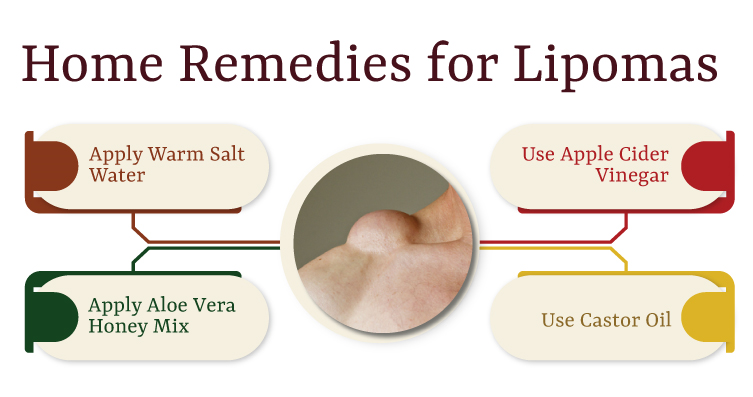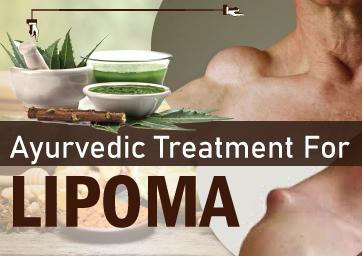What is Lipoma?
Lipomas are benign tumors commonly known as fat deposits. It is usually not harmful, but it can be unsightly and can cause discomfort if it is in a sensitive area.
Lipomas are often called "soft" or "benign" tumors. They and non-cancerous and do not spread to other body parts. Lipoma removal involves surgical excision of the lump.
However, Benign tumors like Lipoma are not cancerous cells and therefore do not have the potential to spread to other body parts. Benign tumors may cause pain and discomfort but do not need more rigorous treatment like Chemotherapy.
Lipoma is just one of many different types of benign tumors. Here are some examples:
• Fibroma (fibrous tumor)
• Hemangioma (blood vessel tumor)
• Angiolipoma (blood vessel tumor with fat)
• Neuroma (nerve sheath tumor)
• Neurofibroma (neural sheath tumor)
If you are bothered by a lipoma, several treatment options are available. You can have it removed surgically or try an Ayurvedic natural treatment for Lipoma.

What Causes Lipomas?
So what causes lipomas, exactly? Well, that's a bit of a mystery.
The cause of Lipoma is unknown, but it may be due to genetics and lifestyle factors.
Lipomas can also develop in areas with chronic inflammation, and some experts believe that they indicate that the immune system is malfunctioning. There are many factors responsible for developing lipomas. The following causes may lead to lipoma formation:
• Fatty foods
• Obesity
• Hormonal imbalance
• Stressful lifestyle
• Aging
• Genetics
• Chronic disease
Lipomas occur primarily in adults, though rarely; they can occur in children too. Based on research, women are twice more likely to get them than men. They often appear on the back, neck, shoulder, chest, abdomen, buttocks, thigh, leg, arm, and foot.
Lipomas may first seem like minor lumps or bumps under the skin. But they are slow-growing tumors lasting 10 to 20 years before developing into painful nodules. So don't ignore them as a cosmetic issue—they may indicate more serious underlying health issues.
Types of Lipomas
There are two types of Lipoma: Subcutaneous (under the skin) and Intramuscular (in muscle). Most people have subcutaneous lipomas, while only about 5% of people have intramuscular ones. Lipomas are not cancerous, nor do they spread to other parts of the body. However, they can cause pain and discomfort if located near nerves or blood vessels.
What Are the Symptoms of Lipomas?
Most people don't even know what Lipoma is. Since most people aren't even familiar with that, most people don't recognize early signs of Lipoma.
So what are the symptoms of lipomas? Generally, they're just lumps or bumps on the skin. They can be soft or firm and grow anywhere on the body. But the most common places for lipomas to develop are on the neck, shoulders, chest, and back.
Even if you suspect you might have a lipoma, visit your doctor. And if you have one, don't panic! Treatments for Lipoma are available to help get rid of it.
How Are Lipomas Diagnosed?
You're probably wondering how lipomas are diagnosed. Right? Well, the first step is to have a physical examination. Your doctor will look at your skin to see if there are any lumps or bumps that could be a lipoma.
If your doctor suspects you have a lipoma, they will order some tests to confirm the diagnosis. These tests might include an ultrasound scan, a CT scan, or an MRI.
The good news is that most lipomas are not cancerous and can be treated with surgery or ayurvedic medicine for Lipoma.
What Is the Ayurvedic Treatment for Lipomas?
Ayurveda is an old Indian medical system practiced for countless years. And it's an excellent treatment for lipomas because it focuses on restoring balance and harmony in the body.
Let's take a closer look at how Lipoma Ayurvedic medicines work:
In Ayurveda, lipomas are known as Vajikarana-Kshaya (tissue formation). 'Vajikara' means tissue formation, and 'Kshaya' means accumulations. According to Ayurveda, a lipoma is caused due to excessive accumulation of adipose tissue or body fat. There are many ways to treat Lipoma. One of them is to use ayurvedic herbs.
Certain ayurvedic herbs help in treating Lipoma naturally. They are called Rasayana herbs. These herbs are used to balance hormones and boost immunity. They are also believed to reduce inflammation and increase blood circulation.
There are two types of Lipoma – soft and hard. Both kinds of lipomas are treated with ayurvedic medicines.
● Soft lipomas are cured by combining ayurvedic herbs and homeopathic medicine.
● Hard lipomas are cured by applying the herbal paste to the affected area.
You should consult a doctor before taking homeopathic medicine. In the case of lipomas, the following ayurvedic treatment is suggested:
● Step1: Take one teaspoon each of turmeric powder, black pepper powder, and ginger powder. Mix them well.
● Step2: Add half a cup of coconut oil to this mixture. Mix thoroughly and wait until the mixture cools down
● Step3: Next, clean the Lipoma area with a clean cloth and apply the mix.
● Step4: Massage the mixture onto the affected area twice daily for about 15 minutes.
● Step5: Wash off the mixture with warm water after 30 minutes.
Do this once every day for the next four weeks. This ayurvedic treatment has no adverse side effects. Make sure the region around the Lipoma is clean, though. Avoid rubbing the area where you put the oil. Just massage the Lipoma with the oil.
Oil Massage Therapy for Lipoma
Many natural treatments for Lipoma reduce their size and make them easier to manage. One of these treatments involves applying hot oil massages.
Hot oil massage therapy uses heated oils to penetrate deep beneath the skin's surface. As the oil warms up, it loosens dead cells and stimulates the lymphatic system to remove toxins and impurities.
Applying warm oil to the affected area can also help relieve pain and discomfort caused by fibrous lipoma tumors. It aids in promoting blood circulation, which improves the delivery of oxygen and nutrients to the affected tissue.
Are There Any Home Remedies for Lipomas?
Fortunately, there are a few lipoma home remedies you can try. We have listed below the most straightforward and risk-free DIY remedies. Hope you will find these helpful.

● Warm Salt Water: Apply warm salt water to the area. It will help soften the fatty tissue and make it easier to remove.
● Use Apple Cider Vinegar: Apply it to the Lipoma using a cotton ball before bedtime. The vinegar acids will help break down the fatty tissue. Wash it the following morning.
● Apply Aloe Vera Honey Mix: It is an excellent remedy for lipomas. Apply this mix to the affected site, and cover it with a bandage. Remove it the following day after leaving it overnight.
● Use Castor Oil: Finally, you can also massage them using castor oil. It is a natural laxative, so it will help soften and remove the lump. Massage the oil twice a day for the best results.
You can use the above Lipoma treatment at home without any side effects. However, if you experience no relief, it's always wise to consult a doctor.
Is Surgery Good for Lipomas?
Should you choose to have surgery? It primarily depends on the size and location of the fatty tumor.
Your doctor could advise just keeping an eye on the Lipoma if it is small and not causing any issues. But surgery might be the best choice if it's big or in a sensitive place.
The good news is that most patients recover fast from lipoma surgery, which is a reasonably straightforward procedure.
Who are at Higher Risk of Lipoma?
Lipomas are lumps of fatty tissue that can form just about anywhere in the body. And while they're not harmful, they can be unsightly and sometimes painful.
The cause of lipomas is unknown. People who have had surgery or radiation treatment for cancer are at greater risk of getting lipomas than those who haven't had these treatments.
When to See for Doctor for Lipomas?
In some cases, lipomas may go away on their own. But in other cases, they may continue to grow and become quite large. So when should you see a doctor?
If the Lipoma hurts or is expanding at an alarming rate, you should consult a doctor. If you experience unexplained fever, nausea, or breathing difficulties, do not ignore them. Remember, it's always wise to be safe than sorry. So don't be afraid to visit a doctor if you have any worries.
Concluding Words
While modern medical science offers several treatments for Lipoma, many still use Lipoma ayurvedic treatment. Ayurveda uses natural remedies and treatments, meaning there is no risk of side effects.
To know more about natural treatments for Lipoma, feel free to talk to an expert. It will help you better identify the fatty tumor cause and choose a treatment plan based on the tumor type and location.



 Contact Us
Contact Us







 Hospitals
Hospitals
 Doctors
Doctors
 Diagnostic
Diagnostic
 Pharmacy
Pharmacy
 Health Tips
Health Tips
 Blog
Blog



















Comments